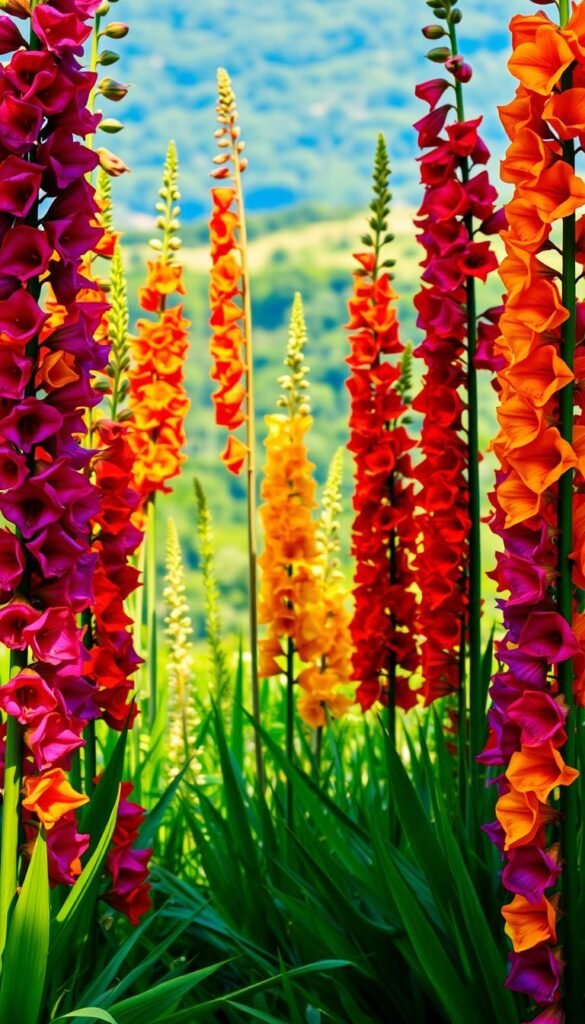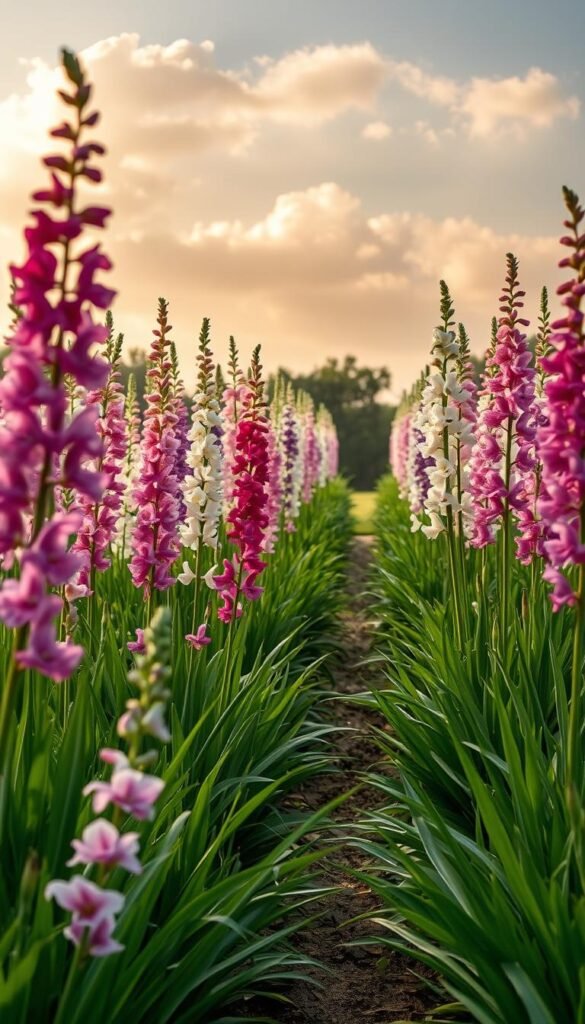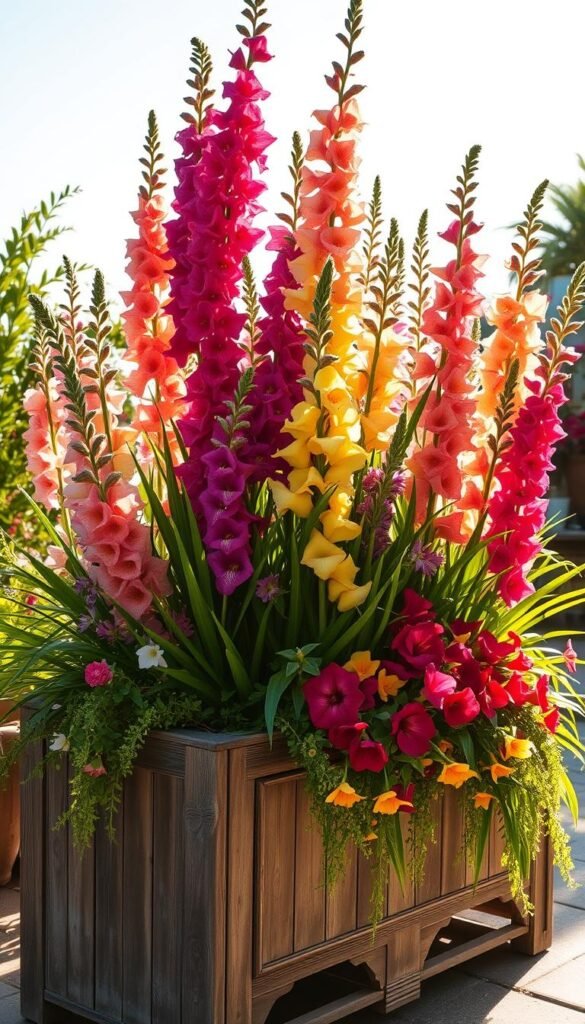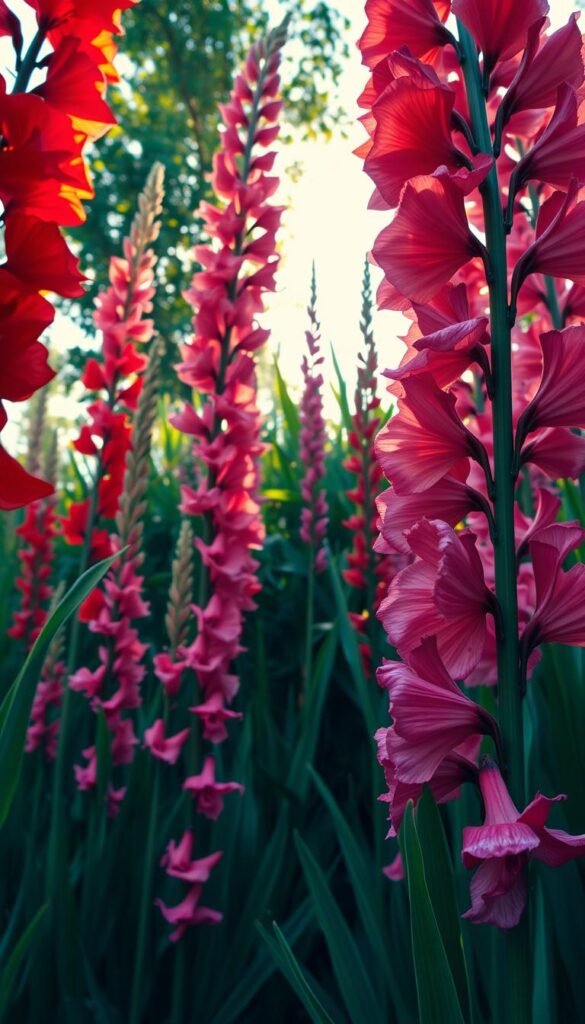Imagine transforming your yard with nature’s living skyscrapers – those towering spikes bursting with color that make neighbors pause mid-step. These botanical marvels offer more than height; they bring structure and drama to any setting.
Their sword-shaped leaves frame blossoms ranging from whisper-soft creams to electrifying magentas. You’ll love how they create natural backdrops for shorter plants while standing proud as solo performers. For inspiration on arranging these showstoppers, explore our guide to bold and beautiful blooms.
What makes these plants truly special? Their vertical growth isn’t just eye-catching – it’s practical. They maximize limited spaces, drawing gazes upward while leaving room for companion plantings below. The Latin roots of their name hint at their secret power: gladius meaning sword, symbolizing strength in your landscape.
Whether framing walkways or anchoring mixed borders, these spiked beauties work harder than typical perennials. Their color spectrum lets you craft moods from serene pastel waves to fiery sunset displays. Ready to rethink your outdoor canvas?
Colorful Vertical Statements with Gladiolus Flower Garden Ideas: Vertical Accents That Steal the Show

Elevate your landscape with living pillars of color that redefine vertical gardening. Strategic design choices turn these spiked beauties into architectural marvels, blending form and function seamlessly.
Understanding Vertical Planting Techniques
Grouping bulbs in clusters of five to seven creates instant drama. This approach delivers 40% more visual impact than single-stem arrangements. Try flanking walkways or framing entry points where their height commands attention.
Stagger bloom times by mixing early and late varieties. You’ll enjoy continuous color waves from spring through fall. “Vertical layers act like nature’s theater curtains,” notes landscape designer Mara Thompson. “They guide the eye upward, making spaces feel larger.”
Maximizing Height and Vibrant Color Variety
Position taller cultivars behind lower-growing companions to create depth. Warm-toned varieties pop against green backdrops, while cool hues add sophistication. For sunset-inspired displays, pair apricot blooms with deep purple salvias.
Small areas shine with focused groupings near seating areas. Larger properties can line driveways with rainbow-hued spikes. Remember: odd-number clusters feel more natural, and proper spacing prevents overcrowding.
Feng Shui Inspired Flower Borders for a Harmonious Garden

Transform your outdoor space into a sanctuary where energy flows freely and beauty meets purpose. Thoughtful design with vertical elements creates visual rhythm while nurturing balance – perfect for those seeking both style and serenity.
Creating Balanced Borders
Mix tall spires with low-growing companions to craft layered displays. Odd-number groupings of three or five create natural harmony. Pair ivory blooms with lavender for calming vibes, or vibrant reds with ornamental grasses for dynamic contrast.
Incorporate curved lines rather than rigid rows to mimic nature’s flow. This approach softens structural elements while maintaining definition. Feng shui master Lila Chen advises: “Let your borders breathe – space plants to allow energy circulation.”
Strategic Placement for Welcoming Spaces
Frame your front path with staggered heights to guide visitors inward. Cluster bulbs near porch steps where their upward growth emphasizes entryways. Backyard designs benefit from using these spires as living screens between relaxation zones.
For modern homes, try monochromatic arrangements in sleek stone beds. Cottage styles shine when mixing peach-toned blossoms with purple coneflowers. Either way, you’ll create focal points that feel intentional yet effortless.
Container Garden Showstopper: Design and Care Tips

Reinvent your outdoor areas with living sculptures that combine elegance with practicality. These towering beauties adapt beautifully to container life, offering flexibility for every space from cozy balconies to sprawling decks.
Selecting the Perfect Containers and Potting Mix
Choose pots that balance style and stability – ceramic or concrete work best. Aim for containers 12+ inches wide to support root growth and prevent tipping. A 70/30 blend of potting soil and perlite ensures proper drainage for healthy bulbs.
| Container Size | Recommended Use | Key Benefit |
|---|---|---|
| 12-14″ | Single variety display | Space-saving height |
| 16-18″ | Mixed companion plantings | Enhanced stability |
| 20″+ | Grouped arrangements | Dramatic focal points |
Positioning for Maximum Visual Impact
Place containers where they’ll grab attention – flanking doorways or lining staircases. Rotate pots weekly for even sun exposure. Urban gardeners love using tiered stands to create vertical drama without floor space.
Benefits for Both Small and Expansive Outdoor Spaces
Compact patios shine with three staggered pots in complementary hues. Larger areas can feature clustered groupings that echo your colorful container arrangements. Mobility lets you chase sunlight or shelter plants during storms.
Pro tip: Insert support stakes early as stems grow. Water when soil feels dry two inches down, and feed every three weeks with 10-10-10 fertilizer. You’ll enjoy continuous blooms from summer through first frost!
Layering Color Palettes and Creative Companion Pairings
Crafting a vibrant outdoor space becomes an art form when you master color layering and plant partnerships. Thoughtful combinations transform simple beds into living tapestries that evolve through seasons.
Techniques for Dynamic Color Arrangements
Start by positioning taller varieties behind shorter companions. This creates depth while letting bold spikes command attention. Warm tones like coral or crimson pop against cool blues and purples for high-contrast drama.
Monochromatic schemes offer elegance. Try pairing ivory blooms with silver-toned foliage. For sunset-inspired displays, blend peach blossoms with golden marigolds.
Pairing with Complementary Plants
Low-growing perennials like creeping phlox fill gaps beautifully. Lavender adds soft texture, while salvia’s spiky blue flowers balance rainbow hues. Pro tip: Marigolds deter pests while brightening beds.
Ornamental grasses introduce movement beside rigid spikes. Black-eyed Susans extend bloom time, creating layered interest. These pairings ensure your color display remains captivating from first bud to final frost.






